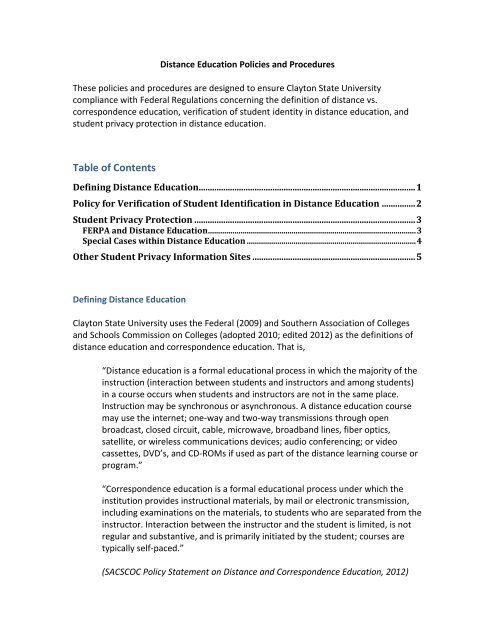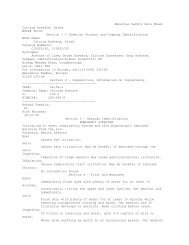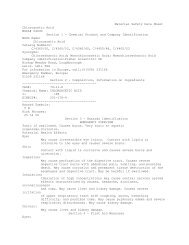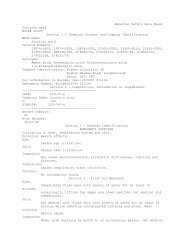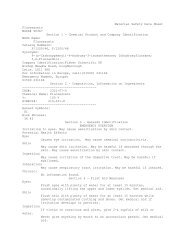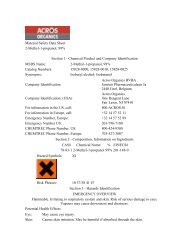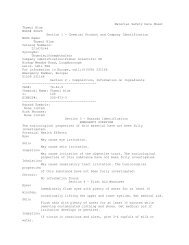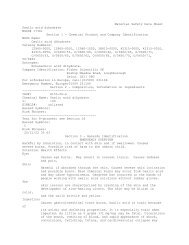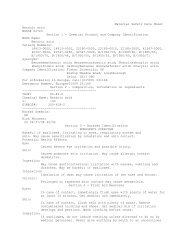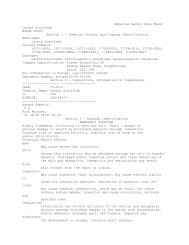Distance Education Policies & Procedures - Clayton State University
Distance Education Policies & Procedures - Clayton State University
Distance Education Policies & Procedures - Clayton State University
Create successful ePaper yourself
Turn your PDF publications into a flip-book with our unique Google optimized e-Paper software.
<strong>Distance</strong> <strong>Education</strong> <strong>Policies</strong> and <strong>Procedures</strong>These policies and procedures are designed to ensure <strong>Clayton</strong> <strong>State</strong> <strong>University</strong>compliance with Federal Regulations concerning the definition of distance vs.correspondence education, verification of student identity in distance education, andstudent privacy protection in distance education.Table of ContentsDefining <strong>Distance</strong> <strong>Education</strong>................................................................................................. 1Policy for Verification of Student Identification in <strong>Distance</strong> <strong>Education</strong> ............... 2Student Privacy Protection ................................................................................................... 3FERPA and <strong>Distance</strong> <strong>Education</strong> ...................................................................................................... 3Special Cases within <strong>Distance</strong> <strong>Education</strong> ................................................................................... 4Other Student Privacy Information Sites ......................................................................... 5Defining <strong>Distance</strong> <strong>Education</strong><strong>Clayton</strong> <strong>State</strong> <strong>University</strong> uses the Federal (2009) and Southern Association of Collegesand Schools Commission on Colleges (adopted 2010; edited 2012) as the definitions ofdistance education and correspondence education. That is,“<strong>Distance</strong> education is a formal educational process in which the majority of theinstruction (interaction between students and instructors and among students)in a course occurs when students and instructors are not in the same place.Instruction may be synchronous or asynchronous. A distance education coursemay use the internet; one-way and two-way transmissions through openbroadcast, closed circuit, cable, microwave, broadband lines, fiber optics,satellite, or wireless communications devices; audio conferencing; or videocassettes, DVD’s, and CD-ROMs if used as part of the distance learning course orprogram.”“Correspondence education is a formal educational process under which theinstitution provides instructional materials, by mail or electronic transmission,including examinations on the materials, to students who are separated from theinstructor. Interaction between the instructor and the student is limited, is notregular and substantive, and is primarily initiated by the student; courses aretypically self-paced.”(SACSCOC Policy <strong>State</strong>ment on <strong>Distance</strong> and Correspondence <strong>Education</strong>, 2012)
<strong>Clayton</strong> <strong>State</strong> offers three different types of technology-enhanced or delivered coursesin terms of scheduling – Full (95% or more online), Partial (more than 50% online) andHybrid (30% - 50% online). It is assumed that for the Hybrid course offerings a majorityof the interaction will take place in the face-to-face environment, therefore only coursesscheduled as Full or Partial will be required to maintain regular interactions betweenstudents and instructors and among students.Policy for Verification of Student Identification in <strong>Distance</strong> <strong>Education</strong><strong>Clayton</strong> <strong>State</strong> <strong>University</strong> must comply with the provisions of the United <strong>State</strong>s FederalHigher <strong>Education</strong> Opportunity Act (HEOA), Public Law 100-315 concerning theverification of student identity in distance learning.All credit bearing courses and programs offered through distance education orcorrespondence must verify that the student who registers for a course or program isthe same student who participates in, completes the course or program, and receivesacademic credit. One or more of the following methods must be used for verificationpurposes:1. An individual secure login and password (CSU username and password).All students at <strong>Clayton</strong> <strong>State</strong> <strong>University</strong> are given a unique username andpassword. While usernames are system-generated, students are not given theirinitial password until their identity is verified. A CSU username and password isrequired in order to gain access to course materials on the learning managementsystem. This authentication method is also the only means of gaining access tocourses/content delivered synchronously through web-conferencing systems.2. Proctored examinations (testing center or online verification)Examinations that are offered at <strong>Clayton</strong> <strong>State</strong>’s Testing Center are proctoredand required students to show a form of identification prior to testing.Additionally, departments and programs can choose to use third-party vendorswho use web-based means to verify and proctor examinations.3. Pedagogical and related practices that are effective in verifying student identity(video chat, review sessions, etc.)Faculty members who teach online also have a responsibility to identify andreport changes in students. These could include sudden changes in academicperformance, change in writing style, using multiple assessment types,conflicting statements made by students in discussions or on email, etc.
Student Privacy ProtectionRegardless of the method used, student identity verification must protect the privacy ofstudent information. Students must be notified at the time of registration or enrollmentof any fees associated with the verification of their identity.Responsible PartiesAll system users are responsible for following the network security policy Passwordsmust be changed every 90 days (via system generated message) in order to maintainsecurity.Faculty teaching courses through distance education have the primary responsibility ofmaking sure that their courses comply with the policies regarding verification andprotection of identity.Deans and Department Chairs are responsible for making sure that faculty are aware ofthe policy and that academic degree programs are in compliance.Academic Affairs is responsible for university-wide compliance and informing deans anddepartment chairs of any changes.The Bursar is responsible for maintaining and publishing any fees associated with theverification of identify.FERPA and <strong>Distance</strong> <strong>Education</strong>All credit bearing courses and programs offered through distance education must assurecompliance with the Family <strong>Education</strong>al Rights and Privacy Act (FERPA). As such, <strong>Clayton</strong><strong>State</strong> <strong>University</strong> personnel must not permit access to or release of any confidentialstudent information to any third parties without written consent of the student otherthan the following (34 CFR § 99.31): School officials with legitimate educational interest Other schools to which a student is transferring Specified officials for audit or evaluation purposes Appropriate parties in connection with financial aid to a student Organizations conducting certain studies for or on behalf of the school Accrediting organizations To comply with a judicial order or lawfully issued subpoenaAppropriate officials in cases of health and safety emergenciesAppropriate external parties, such as law enforcement agencies, in order toinvestigate and respond to suspected violations of law or <strong>University</strong> policy. Anysuch disclosures shall comply with all applicable laws.
Further, electronic student submissions should not be accessible to anyone other thanthe student and the <strong>University</strong> employee who needs the electronic submission to carryout his/her duties. These individuals would usually include the instructor, administratorsor staff approved by the <strong>University</strong>, and e-learning administrators. For student work tobecome available to a third party, the student must give permission. This consent isvoluntary and a student may decline. If a student declines to give consent, the studentcannot be denied any academic opportunity or privilege, or suffer any adverseconsequences as a result.Special Cases within <strong>Distance</strong> <strong>Education</strong>Student Discussion or Forum PostingsWritten consent to display a student’s identity is not necessary for electronicdiscussion or forum postings if: The students perform the posting Electronic submissions do not contain grading or evaluative comments ofa professor. Students are notified in advance via the syllabus that the posting of theirwork is a course requirement. Submitted work is not available to anyone other than other classmembers and <strong>University</strong> approved officials.Sites Outside of the <strong>University</strong>If students are required or requested to post to websites or social networkingsites outside of CSU, FERPA protections as to third parties cannot be assured. Asa result, instructors should inform students of the issues, conditions, andassociated risks at the beginning of the semester using the course syllabus.Instructors should never post student grades, ID numbers or any otherpersonally identifiable information on a third party site. Students should also bewarned against posting personal information about themselves or theirclassmates.Plagiarism Detection Software<strong>University</strong> faculty may use or require the use of plagiarism detection software aspart of their course. <strong>Clayton</strong> <strong>State</strong> currently is part of a <strong>University</strong> System ofGeorgia contract for the use of Turnitin.com. Turnitin.com is a third party systemand therefore faculty should include the following statement on their syllabusindicating the use of the system for plagiarism detection:Students agree that by taking this course all required papers may besubject to submission for textual similarity review to Turnitin.com for thedetection of plagiarism. All submitted papers will be included as source
documents in the Turnitin.com reference database solely for the purposeof detecting plagiarism of such papers. You should submit your papers insuch a way that no identifying information about you is included.Other Student Privacy Information Sites<strong>Clayton</strong> <strong>State</strong> <strong>University</strong> Registrar http://www.clayton.edu/registrar<strong>University</strong> System of Georgia Business <strong>Procedures</strong> Manualhttp://www.usg.edu/business_procedures_manual/section12/C1450


